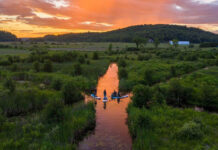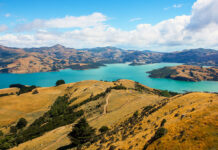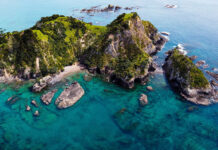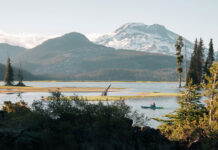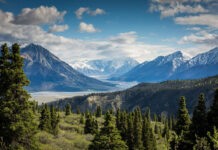TThe couple huddled for warmth in their tent. The tenacious polar wind howled with delight as it threatened
to pry their shelter from its icy footing. Wrapped up in their sleeping bags and damp thermal under-layers Sophie Ballagh and Ewan Blyth could feel the canopy starting to lift off the snow. The cramped nylon dome was their only sanctuary from this hostile environment, and it was losing ground. After nearly two years of planning, the couple couldn’t help but wonder if this, day two of their two-week self-supported Antarctic paddling expedition, might be the end of the line.
For most, just getting to the frozen continent is an adventure in itself. Leaving from the southernmost tip of South America, passengers board sturdy, retrofitted research vessels equipped with reinforced hulls, internal stabilizers and built-in ballast systems to withstand the icy waters and harsh seas. Crossing the dreaded Drake Passage to the Antarctic Peninsula, an arm-like extension of West Antarctica is a two-day voyage exposed to the full brunt of the Southern Ocean. Some days, the passage can be dead calm; on others, a 15-meter swell turns ships to bath toys.
With the undulating waves, endless ocean and no land in sight, it’s amazing to watch the seabirds gliding effortlessly alongside the boat. Some species, like the wandering albatross, spend years at sea never touching land. Beyond this feathered escort, occasional tall plumes of spray mark the blows of distant whales.
After a day of steaming toward the bottom of the world, the air temperature grows noticeably colder; here and there the boat
passes bobbing bits of smooth blue ice. Out in the salty waters, they appear like mythological creatures: beautiful and spectacular icebergs. The largest tower multiple stories high and extend many street blocks wide, yet these are only small portions of unseen giants. Some of these icy cathedrals are fancifully shaped, while others, called tabulars, have vertical cliff-like sides with the flattest of tops.
Then come the views of land. A frozen, mountainous scene of majestic proportions riddled with rocky outcroppings and ancient
glaciers. A remote, impregnable wilderness discovered less than 200 years ago, the fixation of many explorers’ dreams and, often, the instrument of their demise. First conceived by Aristotle, Terra Australis Incognita—the Unknown Southern Land—remained merely a legend for the next two millennia. It wasn’t until 1820 that the continent’s existence was confirmed, and another near-century would pass before the first explorers penetrated its interior, racing for the South Pole. The history of this Heroic Age of Antarctic Exploration is rife with calamity, suffering and the intoxication of discovery.
“It’s a paradox between a place that is so stunning and fairytale one moment, and then so cantankerous and evil the next, you feel there is something personal about it,” Blyth muses. “There is no middle ground, the vast differences are what strike me most about Antarctica.”
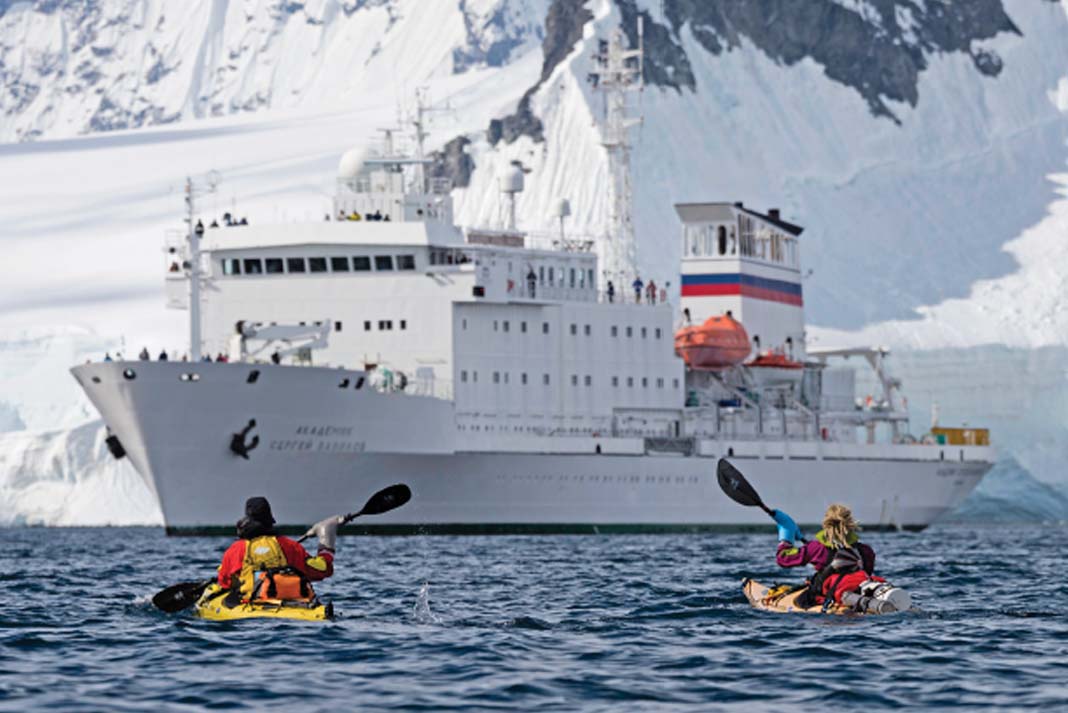
When the opportunity to embark on a self-supported paddling trip along the Antarctic Peninsula came their way, Blyth, 33, and Ballagh, 30, knew they had been gifted the chance of a lifetime. The two met while working as kayak guides for One Ocean Expeditions, a polar exploration tour operator that hits both the Arctic and Antarctic with their fleet of hardy Finnish oceanographic vessels and crews of equally hardy Russian sailors. Leading passengers on short paddling excursions in this ice-locked wilderness, the couple yearned to immerse themselves more deeply in the landscape. What would it feel like, they wondered, to live closely with Antarctica, not just for hours, but for weeks?
It was their boss, Aaron Lawton, who casually mentioned the idea of the pair breaking up their Antarctic work season with an unusual vacation. Between guiding stints on the boat, Lawton suggested the vessel could drop them off and arrange a pick-up further along the coast. A seasoned Antarctic explorer himself, Lawton and his wife had completed their own self-supported trip in 2001. At the time, he estimated they were perhaps the third or fourth paddling party to make a trip of this kind. The Lawtons’ experience and expertise laid the groundwork for commercial overnight kayaking trips on the Peninsula.
Today, One Ocean Expeditions offers day trips and two-day tours for small groups of kayakers in the stunning Errera Channel and Paradise Harbour areas. Guests sleep out in rugged tents and sample camp-baked cinnamon buns, enjoying a curious blend of comfort and vulnerability beneath the wide Antarctic sky. But while small pods of kayak tourists deploying from their motherships are now an increasingly familiar summer sight along the Antarctic Peninsula, self-supported paddling trips remain rare.
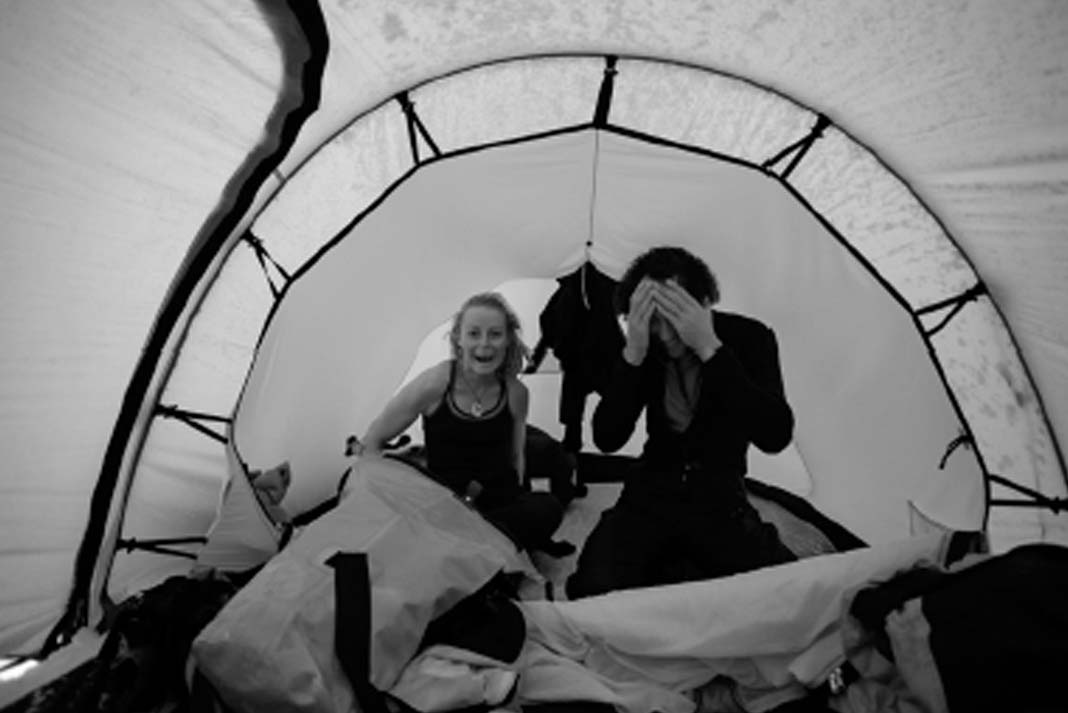
“You need two key things that usually break an expedition of this sort,” explains Blvth. First is “financing the phenomenal costs involved in getting there.” Then, to obtain the necessary permits, you have to work with someone who can undergo a rescue if you need help, also very costly.” Amazingly, they had been granted both.
With One Oceans’ ship as their primary safety backup, Blyth and Ballagh would also carry a satellite phone, VHF radios and contact info and sail plan itineraries for all other vessels scheduled to be around the peninsula during their trip.
All that remained was sourcing the highly specialized equipment needed to paddle and survive in a polar climate. From their living room in New Zealand, Ballagh and Blyth planned, devised and engineered. Gear that wasn’t available commercially, the pair fabricated themselves. A sewing machine and various adhesives transformed fabrics, foam and hardware supplies into sea drogues, snow anchors, thermos and battery insulators, and more. Prototypes were tested in their kitchen freezer to simulate summer conditions in Antarctica, when polar winds can plunge temperatures to below -20°C
Sun and calmer conditions lured Ballagh and Blyth out of their cocoon after 48 hours pinned down by blustering winds and sub-zero temperatures.
They’d named the site of their exile One Day Island, as in, “One day we’ll get off this blood island.” The apparent lull in the weather seemed to be their chance, and they pushed hard to pack as quickly as possible.
Tearing down camp, donning drysuits over three layers of thermal clothing, and loading the hatches and decks of each 17-foot plastic kayak with 200 pounds of provisions, camera gear, communication devices and navigational equipment took nearly three hours. On the water, the homemade pogies the couple had fashioned from foam sleeping mats insulated their hands against the Antarctic cold, but on land all of their gloves were soaked from hauling gear and packing boats. Tucking moist layers inside their sleeping bags at night had done little to dry them out and their fingers quickly grew numb while they hurried to pack. The last of the gear would have to be squeezed in between and around their legs once seated in the kayak, a precarious balancing act in the sloppy shore waves.
Petite yet powerfully built, Ballagh was first to pull out towards the open water past the island’s protection. While they had been packing, the wind had shifted. Beyond the lee of One Day Island, the ocean was roaring. Sea spray assaulted the paddlers from all sides.
“We got 20 meters off the shore and realized it was too dangerous,’ recalls Blvth.
“It had taken us hours to pack everything up, then within 15 minutes we were pulling the kayaks back up on shore, unpacking them, putting the tent back up in the exact same place.” It was a frustratingly low point for Blyth. “We had wasted six hours of time and energy, and gotten really cold and wet, to achieve nothing.
With each day they spent trapped on the island, Ballagh and Blyth knew they were losing precious time to complete their planned itinerary. The Akademik Sergey Vavilov had dropped the kavakers off near Peterman Island, a small ice-crusted mound of rock home to a large Gentoo penguin colony. As the couple paddled north, the ship would finish its voyage, cross the Drake, pick up its next group of passengers in Argentina, then make its way back to the Antarctic Peninsula. If all went as planned, the Vavilov would rendezvous with the kavakers in Wilhelmina Bay 14 days after their drop-off.
Finally, on day five, after what seemed like an eternity, the weather released its hold.
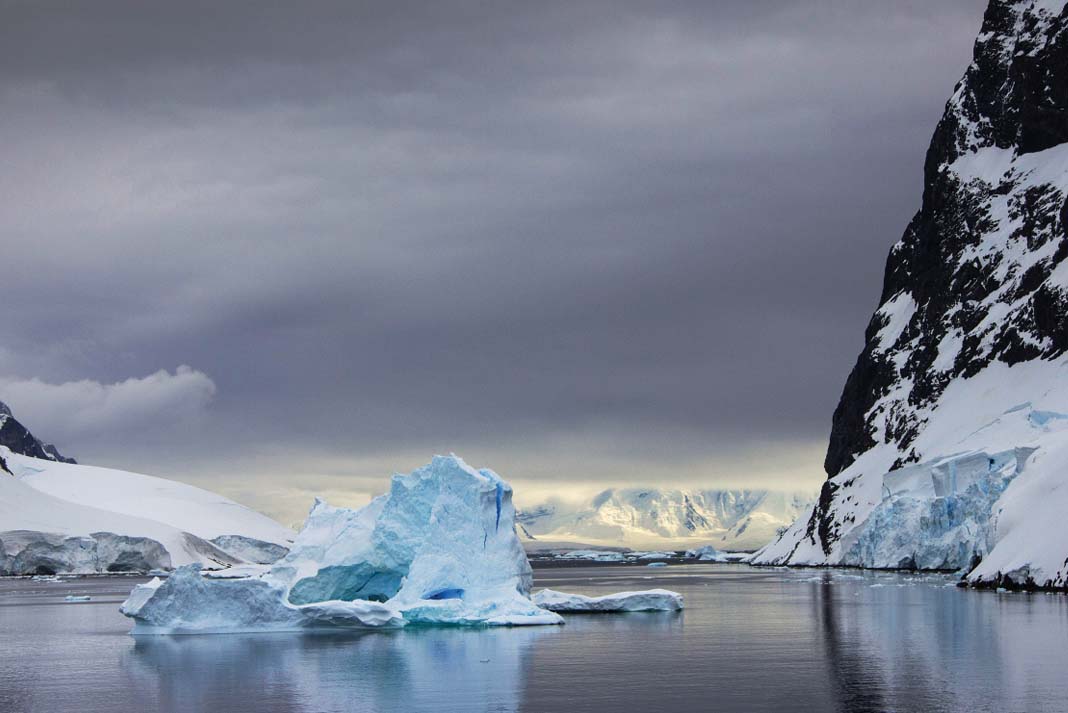
“The great white continent is so silent, it’s deafening,” marvels Ballagh. Traveling in late January, just after the Antarctic summer solstice, the pair experienced near-perpetual daylight. Paddling by day and soft twilight, even time grew quiet in the vast landscape of mute snows and wordless peaks.
“In that silence you hear nature, you hear whale blows and penguins squawking,” she says. “You listen to the ice and glaciers moving, cracking and booming.” At other times, only the scraping of brash ice against kayak hulls accompanied their passage through fields of tiny bergs littering the ocean’s surface.
Antarctica showed her fairytale face as the couple paddled past Weddell seals sunning themselves on ice floes and inquisitive chinstrap penguins waddling clumsily or flying acrobatically beneath their kayaks. It’s that connection with the natural world that is so meaningful, says Ballagh. She’s quick to point out that shorter trips in wild spaces closer to home can foster the same connection. Still, there’s no denying the frozen continent is special. “I love being remote, I love the isolation. It’s what makes me tick.”
Leaving their icy campsite at Pursuit Point on day eight, Ballagh and Blyth gazed across the deceptive calm of the Gerlache Strait. Reaching Wilhelmina Bay and their pick-up meant crossing the eight-nautical-mile-wide channel of icy water. Despite the benign breeze, sparkling water and patches of cobalt blue sky, Ballagh’s nerves were running high.
“The Gerlache is big water, the wind waves that can form there are huge,” she explains. “If you’re out in the middle and the weather changes, which it can do very quickly, you’ve got nowhere to run.” Antarctica’s abrupt mood swings had pushed the paddlers to the limits of their endurance the day before in an area far less exposed than the Gerlache. Traveling up the coast of Wiencke Island, unable to land on the icy, six-foot-high ramparts guarding the glaciated shore, they had spent five hours beating into a frigid headwind. The ordeal had taken its toll on the couple.
Conditions had been so severe they couldn’t stop paddling to wipe the salt from their eyes or the snot streaming in frozen icicles from their noses. The wind edged up to a constant 25 knots, with gusts to 30. “I was wrecked,” remembers Ballagh. “I was going backwards at one point, I just couldn’t hold ground against the wind. I was giving it everything in my tank, and I couldn’t push the boat forward.”
The prospect of crossing the Gerlache the next morning, with tired bodies, still-frozen gear and weary minds, was sobering. “My heart was in my mouth the whole way across,” says Ballagh.
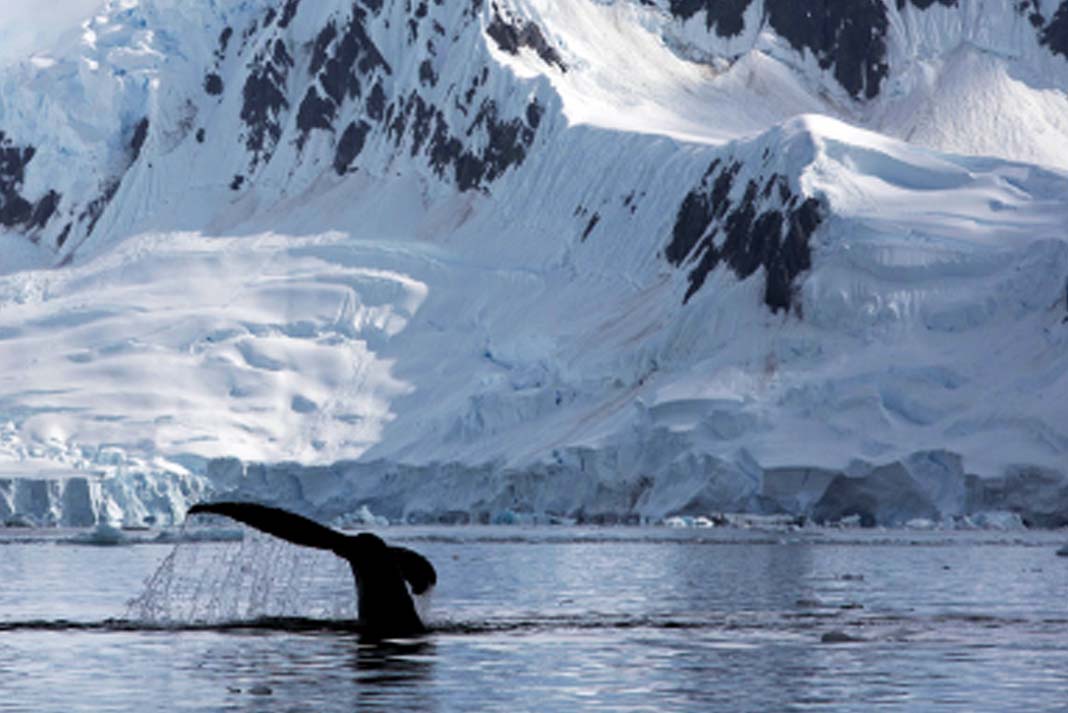
Casting furtive glances over their shoulders at the clouds lurking on the southwestern horizon, the kayakers hurried across the strait. Incredibly, the weather held, and they were even joined by an escort of humpback whales for part of the crossing. The mix of emotions Ballagh describes—elation, anxiety, uncertainty—was not unlike that experienced by a mountain climber summiting a long-fought peak.
“It was so beautiful, I tried to enjoy it, but at the same time I was worried that we were going to get slammed out there.”
Perched on a rocky outcrop high above the ocean in Wilhelmina Bay, the couple savored their last night alone. Hauling their gear up a precipitous incline to pitch their tent on this icy cliff had been a fitting end to their 110-nautical-mile exploration of the Antarctic Peninsula. Majestic snowy mountains and mercurial waters stretched as far as their eyes could see. Despite the hardships they’d endured, tomorrow’s rendezvous with the Vavilov would be bittersweet.
When she’s not studying arts and film, Caroline Stroud works seasonally in the Arctic and Antarctic as an expedition guide.

Watch ICEOLATION in the Paddling Film Festival’s Adventure Program
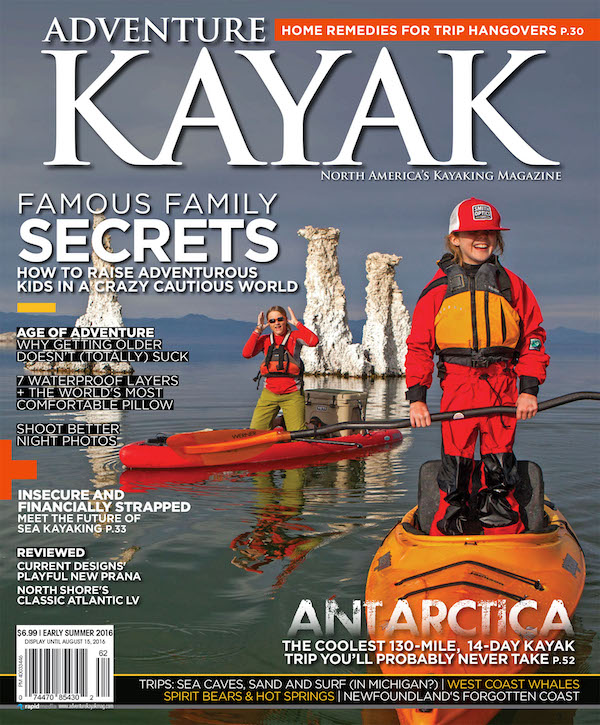 This article originally appeared in the Adventure Kayak Early Summer 2016 issue.
This article originally appeared in the Adventure Kayak Early Summer 2016 issue.
Subscribe to Paddling Magazine and get 25 years of digital magazine archives including our legacy titles: Rapid, Adventure Kayak and Canoeroots.



